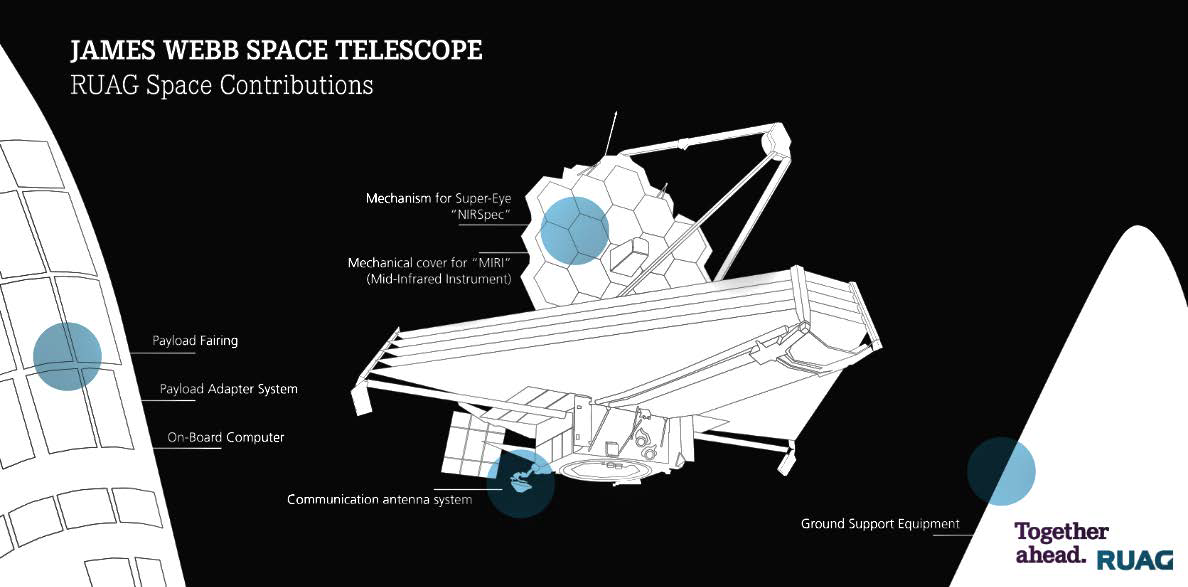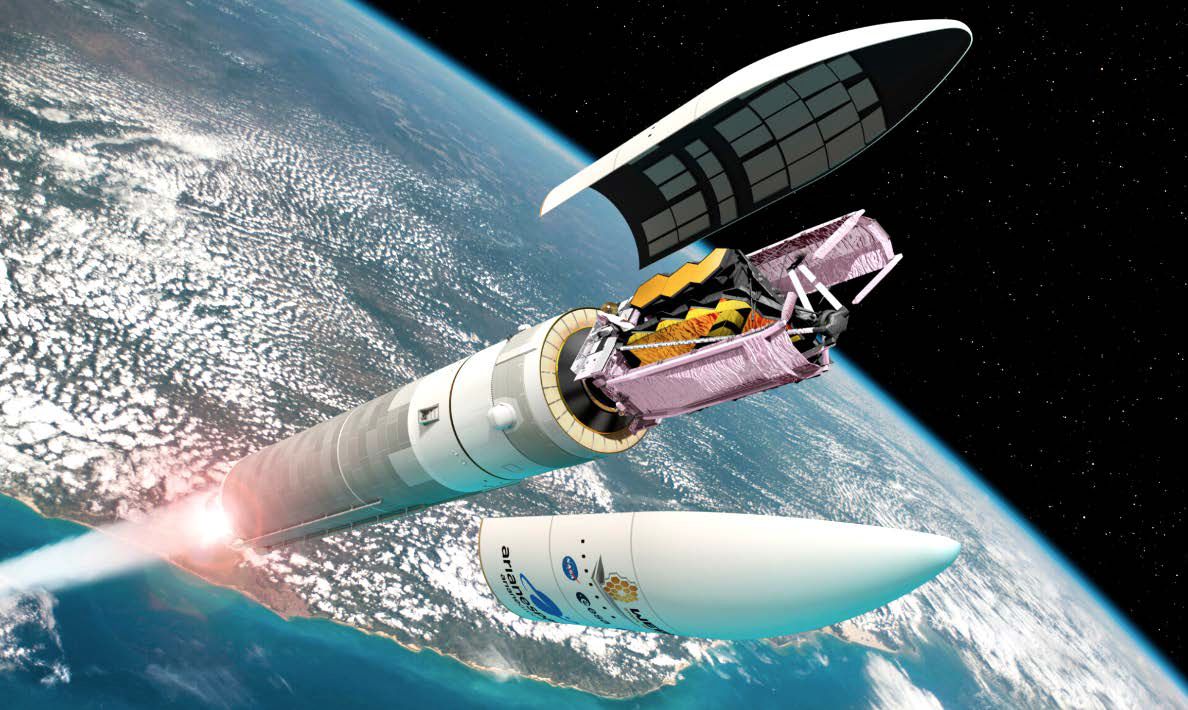RUAG Space’s engineering and production capabilities are playing a central role for the James Webb Space Telescope (JWST) that was launched by Arianespace from the Kourou Spaceport in French Guiana on December 22, 2021. In addition to the payload fairing, separation system and on-board computer for the Ariane 5 launch vehicle, the company delivered the antennas for data transmission to Earth, the ground support equipment as well as three mechanisms for two of the telescope’s four scientific instruments.

The James Webb Space Telescope (JWST) — or short “Webb” — is the largest and most powerful space telescope ever built. The satellite was developed under the leadership of NASA in cooperation with the European and the Canadian Space agencies. This successor of the Hubble Space Telescope will be able to peer into the oldest, most distant areas of the universe to study some of the first stars and galaxies that formed after the Big Bang more than 13.5 billion years ago.
A Collaborative Effort
For a quarter of a century, thousands of engineers and hundreds of scientists across the globe worked to make Webb a reality, along with more than 300 universities, organizations and companies from 29 U.S. states and 14 countries. Additionally, RUAG Space contributed to the mission with key technologies.
“Like no other mission, Webb demonstrates what the international space community is capable of. The revolutionary technology will study every phase of cosmic history — from our solar system to the most distant observable galaxies in the early universe.
One hundred times more powerful than its predecessor, Hubble, the JWST will change the way we see our universe. We are proud to be part of this global collaborative effort that will help us understand ourselves, our solar system, and the history of our universe better than ever before,” said André Wall, the CEO of RUAG International. “In addition to the payload fairing, the computer and the separation system for the Ariane 5 launcher, we had the honor of supplying the antenna for data transmission to Earth, the ground equipment and three mechanisms for two of the telescope’s four scientific instruments.”
Making Certain Webb’s Data Reaches Earth
The communication antenna system that will transmit collected data from the telescope to Earth was developed and produced by RUAG Space in Gothenburg, Sweden. The system consists of two antennas, one of which is a 0.6 meter diameter reflector made of carbon fiber composite that provides low weight and high precision at extreme temperatures. The second antenna is a small cup type antenna that provides a backup function in another frequency band.
“All of the amazing science data from the telescope will pass through our antennas. Just imagine, for instance, if this turns out to be the missing puzzle piece to help us better understand dark matter,” said Anders Linder, head of RUAG Space’s global satellites business unit.
 Once in orbit the RUAG Space payload fairing is separated into two halves and jettisoned from the launch vehicle, thus permitting the later separation of the James Webb Telescope from the launcher. Copyright: ESA / D. Ducros.
Once in orbit the RUAG Space payload fairing is separated into two halves and jettisoned from the launch vehicle, thus permitting the later separation of the James Webb Telescope from the launcher. Copyright: ESA / D. Ducros.
Three Mechanisms For Webb’s Scientific Instruments
RUAG Space was responsible for three crucial mechanisms for two of the telescope’s four scientific instruments. Two high-precision mechanisms for the telescope’s “super eye” — called NIRSpec — were developed, built and tested by RUAG Space’s site in Vienna, Austria. This includes the mechanical support structures and special ball bearings of the two filter systems referred to as the instrument’s Filter Wheel Assembly. The 200-kilogram “super eye” — one of the two European contributions to the mission — can detect faintest infrared radiation from the most distant galaxies. Designed to observe 100 objects simultaneously, the NIRSpec will be the first spectrograph in space that has this remarkable multi-object capability.
An extremely versatile instrument, the second European instrument “MIRI” (Mid Infrared Range Instrument), will support all four of JWST’s science themes. The instrument’s Contamination Control Cover was developed by RUAG Space in Zurich, Switzerland, and delivered in 2008. The cover will protect MIRI against external contamination during the cool down phase of the tests and after the launch. Additionally, this cryo-mechanism acts as an optical shutter for the instrument to allow on-board calibration and to protect the detectors against bright objects. MIRI will help to see the first generations of galaxies born after the Big Bang.
Crucial Products for A Successful Launch
During assembly, a rotating and tilting device developed and produced by RUAG Space in Vienna enabled engineers to work on the telescope from all sides. The trolley moves the telescope to a vertical or horizontal position. RUAG Space has already delivered more than 80 “multipurpose trolleys” that can rotate and tilt a satellite to customers in Europe and the United States.
RUAG Space’s payload fairing topped the Ariane 5 rocket and protected the JWST during liftoff and then the telescope’s journey through the atmosphere. The 17-meter-high structure was produced at the company’s site in Emmen, Switzerland.
The Webb’s sunshield — as big as a tennis court — was specially engineered to fold up and fit within the 5.4-meter diameter fairing.
“Our fairing was custom-made for this precious payload,” said Holger Wentscher, who heads RUAG Space’s Launchers business unit. “New hardware ensures that venting ports around the base of the fairing remain fully open. This minimized the shock of depressurization when the fairing was jettisoned away from the launch vehicle.”
On its way into space, the launch vehicle is controlled by a RUAG Space, on-board computer. When the payload reached a certain height, the two halves of the payload fairing were separated and jettisoned from the launch vehicle.

“All of the amazing science data from
the telescope will be transferred to
Earth via our antennas,” said Anders
Linder, Senior Vice President Satellitesat RUAG Space.
Image copyright: RUAG
The corresponding separation system was manufactured by RUAG Space in Linköping, Sweden. Later, this separation system (payload adapter) allowed the JWST to be separated from the launch vehicle.
JWST: Studying The Birth of Galaxies, Stars and Life
Named after James E. Webb, NASA Director between 1961 and 1968, JWST will directly observe a part of space and time never before observed. Webb will gaze into the epoch when the first stars and galaxies were formed, more than 13.5 billion years ago. Ultraviolet and visible light emitted by the first luminous objects has been stretched, or “redshifted,” by the universe’s continual expansion and arrives today as infrared light. Webb is designed to “see” this infrared light with unprecedented resolution and sensitivity.
The Webb has four scientific missions: finding the earliest stars and galaxies, understanding how galaxies evolved, observing the formation of new stars and solar systems, and scanning Earth’s neighboring planets for their chemical properties and signs of life.
The main instrument of the JWST is an infrared telescope with a reflector 6.5 meters in diameter. Unlike its predecessor Hubble, which observes the universe from a height of a few hundred kilometers above the Earth, the JWST will orbit around a point 1.5 million kilometers from the Earth. This will maintain the spacecraft in the same relative position to the Sun and the Earth to keep the telescope’s temperature very low behind its large solar shield. This is necessary for the Webb’s sensitive instruments to function properly.
RUAG Space is delighted to have played an important, supporting role for the JWST mission.
www.ruag.com

